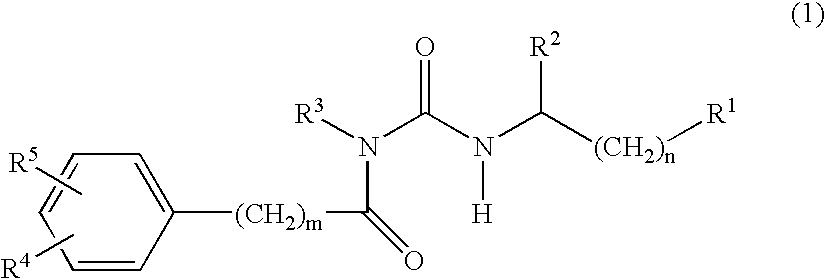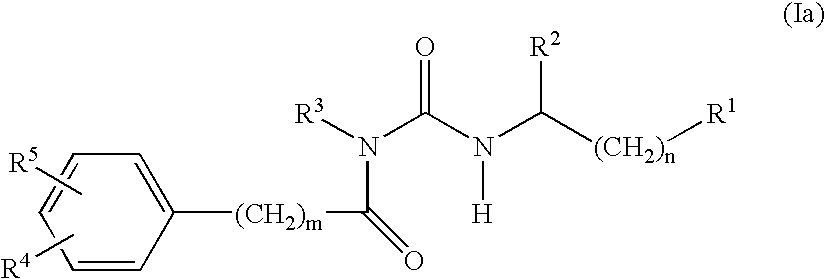Alpha-helical mimetics
a technology of alpha-helical mimetics and peptides, applied in the field of alpha-helical mimetics, can solve the problems of short peptide sequences, insufficient maintenance of alpha-helical conformation, and instigate or worsen major diseases
- Summary
- Abstract
- Description
- Claims
- Application Information
AI Technical Summary
Problems solved by technology
Method used
Image
Examples
example 1
Compound (1)
[0300]
1A: N-n-propyl-3-bromobenzamide
[0301]Using Preparation Method 1,3-bromobenzoic acid was reacted with n-propylamine. The resulting reaction mixture was purified using SiO2 with CH2Cl2 (100%) to CH2Cl2 / MeOH 99:1 to give N-n-propyl-3-bromobenzamide as an off-white solid (79%). NMR 1H (ppm, CDCl3): 7.86 (s, 1H), 7.63 (d, J3=7.74 Hz, 1H), 7.50 (d, J3=7.00 Hz, 1H), 7.19-7.13 (m, 1H), 7.02 (br. s., 1H), 3.33-3.27 (m, 2H), 1.54 (sext., J3=7.34 Hz, 2H), 0.88 (t, J3=7.42 Hz, 3H).
1B: N-n-propyl-3-phenylbenzamide
[0302]Using Preparation Method 2, N-n-propyl-3-bromobenzamide from Example 1A was reacted with phenyl boronic acid. The resulting reaction mixture was purified using SiO2 with CH2Cl2 (100%) to CH2Cl2 / MeOH 90:10 to give N-n-propyl-3-phenylbenzamide as a white solid (96%). NMR 1H (ppm, CDCl3): 7.97 (t, J4=1.53 Hz, 1H), 7.69 (dd, J3=7.91 Hz, J4=1.84 Hz, 2H), 7.61-7.58 (m, 2H), 7.51-7.24 (m, 4H), 6.17 (br. s., 1H), 3.47-3.40 (m, 2H), 1.65 (sext., J3=7.32 Hz, 2H), 0.98 (t, ...
example 2
Compound (2)
[0304]
2A: N-n-butyl 3-phenylbenzamide
[0305]Oxalyl chloride (132 μL, 1.5 mmol) was added over a 10 minute period to a mixture of 3-phenylbenzoic acid (200 mg, 1 mmol) dissolved in a mixture THF / DMF (3.5 mL / 58 μL). After the addition, the reaction was stirred at room temperature for 2.5 hours. n-Butylamine (247 μL, 2.5 mmol) was then added into half of the acid chloride solution at 0° C. The reaction was then stirred at room temperature for 18 hours. The reaction was concentrated and water was added to the residue. The aqueous phase was extracted 3 times with CH2Cl2. The combined organic layers were washed with 2N HCl, saturated NaHCO3, brine, dried over Na2SO4 and concentrated. Diethyl ether was added to the residue and a white solid precipitated. It was collected by filtration and rinsed with a small amount of diethyl ether. The white solid was then dried under vacuum (88 mg, 70%). NMR 1H (ppm, CDCl3): 7.96 (s, 1H), 7.69 (d, J3=8.01 Hz, 2H), 7.59 (d, J3=7.16 Hz, 2H), 7.5...
example 3
Compound (3)
[0307]
3A: N-isobutyl 3-phenylbenzamide
[0308]Oxalyl chloride (132 μL, 1.5 mmol) was added over a 10 minute period to a mixture of 3-phenylbenzoic acid (200 mg, 1 mmol) dissolved in a mixture THF / DMF (3.5 mL / 58 μL). After the addition, the reaction was stirred at room temperature for 2.5 hours. Isobutylamine (247 μL, 2.5 mmol) was then added into half of the acid chloride solution at 0° C. The reaction was then stirred at room temperature for 18 hours. The reaction was concentrated and water was added to the residue. The aqueous phase was extracted 3 times with CH2Cl2. The combined organic layers were washed with 2N HCl, saturated NaHCO3, brine, dried over Na2SO4 and concentrated. Diethyl ether was added to the residue and a white solid precipitated. It was collected by filtration and rinsed with a small amount of diethyl ether. The white solid was then dried under vacuum (102 mg, 71%). NMR 1H (ppm, CDCl3): 7.97 (t, J4=1.71 Hz, 1H), 7.70 (dd, J3=7.65 Hz, J4=1.77 Hz, 2H), 7...
PUM
| Property | Measurement | Unit |
|---|---|---|
| Volume | aaaaa | aaaaa |
| Molar density | aaaaa | aaaaa |
| Molar density | aaaaa | aaaaa |
Abstract
Description
Claims
Application Information
 Login to View More
Login to View More - R&D
- Intellectual Property
- Life Sciences
- Materials
- Tech Scout
- Unparalleled Data Quality
- Higher Quality Content
- 60% Fewer Hallucinations
Browse by: Latest US Patents, China's latest patents, Technical Efficacy Thesaurus, Application Domain, Technology Topic, Popular Technical Reports.
© 2025 PatSnap. All rights reserved.Legal|Privacy policy|Modern Slavery Act Transparency Statement|Sitemap|About US| Contact US: help@patsnap.com



